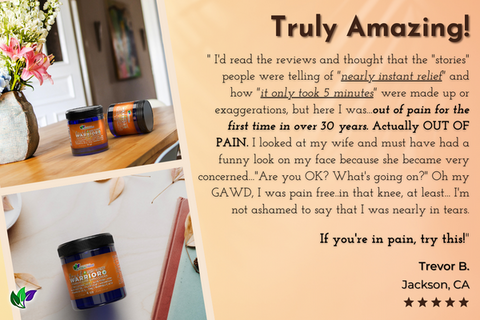DMSO for Arthritis
Do you feel like arthritis is stealing your joy? If joint pain keeps you from living life on your terms, you’re not alone. But there’s hope, and it comes in the form of a natural game-changer: Dimethyl Sulfoxide (DMSO). Known for its powerful anti-inflammatory properties, DMSO has been a go-to for many seeking natural relief. Using DMSO for arthritis could be your golden ticket to getting back to the activities you love, without pain calling the shots.
“If joint and/or muscle pain is interfering with your quality of life, I suggest you give dimethyl sulfoxide (DMSO) a try.” - Dr. Julian Whitaker
Let’s dive into why DMSO is a standout for arthritis relief and how it’s helped thousands—including us at Herbal Mana—regain their freedom from pain.
How DMSO Works
DMSO is absorbed deep into the tissues when applied topically, making it a fast and effective solution. What sets DMSO apart is its ability to act as a natural carrier—transporting other ingredients (like essential oils) deeper into your body for enhanced effects. But that’s not all. DMSO itself has powerful anti-inflammatory properties that get to the root of your pain.
Studies show DMSO not only reduces inflammation but also acts as a free-radical scavenger, meaning it fights off the damaging culprits behind your arthritis. Using DMSO for arthritis could help reduce joint pain, improve range of motion, and even boost grip strength—pretty handy for anyone looking to regain control over their life. See what I did there? 😉
In fact, a clinical trial conducted by the Japanese Rheumatism Association found that DMSO significantly relieved joint pain in 318 patients. That’s a lot of people who got their mobility—and their lives—back.
Why DMSO is Still a Powerhouse
Since the days of aspirin, DMSO was the first non-steroidal anti-inflammatory to be discovered. Dr. Stanley Jacob, known as the “Father of DMSO,” initially explored its potential as an organ preservative, but what he found was even better—DMSO penetrates the skin deeply and safely, making it an ideal remedy for conditions like arthritis.
Doctors, like Stephen Edelson, MD, have been using DMSO for years, both topically and intravenously, to help people with rheumatoid arthritis, chronic back pain, and more. Dr. Edelson called it a “dramatic treatment” for arthritis, offering symptom relief while working on long-term solutions.
DMSO Uses for Arthritis
DMSO isn’t just for quick fixes. It’s especially powerful for chronic arthritis conditions, providing long-term relief from the nagging pain that slows you down day after day.
Here’s why DMSO stands out:
- Anti-inflammatory powers: DMSO targets inflammation at the source, calming overactive immune responses that attack your joints.
- Free radical protection: It shields your joints from damage caused by oxidative stress, a major culprit behind arthritis.
- Sulfur-rich: DMSO is loaded with sulfur, which supports the health of your cartilage, skin, hair, and nails. (Fun fact: cartilage is made up of collagen, which thrives on sulfur.)
Ready to see the difference DMSO can make? Get started today!
When to Expect Results
Everyone’s body responds differently, so the length of time can vary. However, most people see relief from acute injuries within a few hours by applying DMSO every 2-4 hours. For chronic arthritis, it might take 6-8 weeks to notice an improvement, with maximum benefits kicking in after several months of consistent use.
The key here is consistency. Regular use of DMSO can be a total game-changer for chronic pain.
Why Haven’t You Heard More About DMSO?
You’re probably thinking: with all these benefits, why isn’t DMSO more mainstream? Well, it’s complicated. One reason is that DMSO’s signature garlic-like smell makes it tough to conduct blind studies, which are essential for FDA approval.
Then there’s the fact that DMSO can’t be patented, which makes it less attractive for big pharmaceutical companies who don’t want competition for their pricier alternatives.
But here’s the real kicker: veterinarians have been using DMSO on racehorses for years, and we all know there’s no placebo effect on a horse! That should tell you something about just how effective it really is.
Frankincense for Arthritis
Why Frankincense? For thousands of years, this essential oil has been celebrated for its anti-inflammatory, antiseptic, and regenerative properties. The Arthritis Foundation even recognizes Frankincense for its ability to reduce autoimmune responses and prevent cartilage damage—huge wins for people dealing with osteoarthritis.
A 2010 study confirmed Frankincense as a natural powerhouse for reducing inflammation, making it the perfect companion to DMSO for arthritis relief.
That’s why we combined the two in our Frankincense DMSO Gel. Made with 99.995% Pure Pharmaceutical Grade DMSO, Organic Aloe Vera, and sustainably sourced Frankincense, it’s a natural solution for joint, nerve, and muscle pain linked to arthritis.
Why wait? Start your journey to relief today and don’t look back!
Claim Your Bottle of Frankincense DMSO Gel!
Want to learn more? Check out our other blogs about DMSO:
Peppermint Essential Oil + DMSO Uses and Benefits
See what some of our customers are saying!
Segura, Gabriela. “DMSO - The Real Miracle Solution.” Sott.net, 12 May 2011, 8:12, www.sott.net/article/228453-DMSO-The-Real-Miracle-Solution.
“DMSO: Many Uses, Much Controversy.” Pharmacology of DMSO, Alternative & Complementary Therapies, www.dmso.org/articles/information/muir.htm.
“DMSO Represses Inflammatory Cytokine Production from Human Blood Cells and Reduces Autoimmune Arthritis.” PubMed, 31 Mar. 2016, www.ncbi.nlm.nih.gov/pmc/articles/PMC4816398/.
Eberhardt, R, et al. “DMSO in Patients with Active Gonarthrosis. A Double-Blind Placebo Controlled Phase III Study.” Fortschritte Der Medizin, U.S. National Library of Medicine, 10 Nov. 1995, www.ncbi.nlm.nih.gov/pubmed/8529985.
Fuchs, Joanna. “DMSO Uses, BenefitsWhat Does Dimethyl Sulfoxide Do?” DMSO Uses. Benefits of Dimethyl Sulfoxide, www.alternative-medicine-digest.com/dmso.html.
Whitaker, Julian. “DMSO Treatment Relieves Joint & Muscle Pain.” Health Vitamins & Supplements Products, www.drwhitaker.com/dmso-treatment-relieves-joint-and-muscle-pain.
“Indian Frankincense.” Www.arthritis.org, www.arthritis.org/living-with-arthritis/treatments/natural/supplements-herbs/guide/indian-frankincense.php.
Blain, Emma J, et al. “Boswellia Frereana (Frankincense) Suppresses Cytokine-Induced Matrix Metalloproteinase Expression and Production of pro-Inflammatory Molecules in Articular Cartilage.” Phytotherapy Research : PTR, U.S. National Library of Medicine, June 2010, www.ncbi.nlm.nih.gov/pubmed/19943332.
**These statements have not been evaluated by the Food and Drug Administration. Not intended to diagnose, treat, cure, or prevent any disease or health condition.






